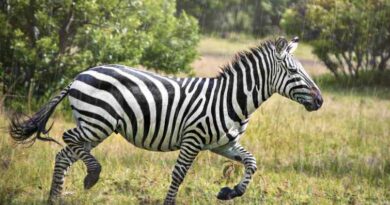DOLPHIN
Dolphins are loved by everyone. They seem to be the best example of how friendly, active, and funny animals can be. More and more often, TV shows and friends have taken us into their underwater world, making us feel like we know them well. People have said that they can almost do magic, but what are they really like?
The dolphin is like a small whale. It has smooth, hairless skin, and its body is beautifully shaped and very athletic. It can reach speeds of over 20 miles per hour by using its strong flippers and strong up-and-down thrusts from its muscular tail. It is about the size of a seal and doesn’t weigh much, so it can jump high out of the water and make a big arc before diving back into the waves. Anyone who has seen a group of wild dolphins jump, dive, and move back and forth in the ocean will never forget the sight. It is fun to watch an animal that is so at home in the water.
The dolphin starts out as a baby that is a metre long and looks just like its mother but smaller. Since it is a mammal that lives its whole life in the water, its first problem when it is born is how to get some air. It can’t breathe underwater like a fish because it doesn’t have gills. After sliding out of its mother’s body tail-first, it might be able to swim to the surface on its own, but if it is too weak, it will need help. Help is always close by, though, because the mother’s other women friends act as midwives when a baby is about to be born. They stay close together and are ready to help the baby dolphin get to the surface. They also keep an eye out for any possible dangers and protect both the mother and her baby from enemies.
The baby will stay with its mother for a few years, feeding on her milk like any other mammal. It takes a very long time for a baby dolphin to be nursed by its mother, but there is a lot to learn in the world of dolphins, and childhood should not be rushed.
The mother needs to go fast fishing once in a while, which means she has to leave her baby behind. She can’t just leave it alone, so the other women with her help her out again. While she is gone, one of them takes care of and watches out for her baby until she gets back. As soon as she comes back, her baby starts to make excited noises.
The dolphin’s whole way of life is based on being helpful. They not only give birth to and watch over young dolphins, but they also take care of sick or hurt adults. The animal’s companions gently lift it to the surface by putting their heads under its flippers. They hold it up there so that its blowhole can take in air. Unless they did this, it would soon sink.
The dolphin’s desire to save a drowning animal is so strong that it has even saved a human swimmer in trouble. One woman was pulled under by a strong current and was almost dead when she was pushed up to the surface and then found toward the shore until she was safe. She had no idea who was helping her in this way, so she was completely confused. Later, a witness told her that he had seen a dolphin do the rescue. Dolphins spend a lot of time with other dolphins. This is especially important when it comes to how they eat. They eat fish, but they rarely do it in a simple way, with one dolphin chasing after one fish.
They prefer to act together to catch fish. When they hunt together, they can make fish swim toward each other. Working together, they distract the fish long enough for them to be easy to catch. Different groups of dolphins confuse fish in different ways. In one case, they were found to take turns eating. The whole group would gather around a big school of fish and herd them into a tight pack. Then, one dolphin would swim through the group of fish and eat as much as it could while the others surrounded them. Then it would stop eating and let the next one eat as much as it could. This went on until each of the dolphins in the group had a chance to eat.
In some places, dolphins have been known to help fishermen catch more fish by herding schools of fish into the men’s nets. Dolphins have been seen jumping high out of the water to keep a way on seabirds in other places. When seabirds find a very large school of fish, they all gather there to catch their food. Every time the dolphins jump out of the water, they quickly scan the ocean with their eyes to look for a cluster of seabirds like this. When they see birds eating, they swim quickly to where they are and start hunting there.
The dolphin’s mood changes after it has eaten. Instead of getting sleepy like many other well-fed hunters, they become very playful. They keep swimming into and out of each other’s groups, changing their positions, speeds, and directions all the time. They use their flippers to pet each other. They swim side by side or poke each other with their sharp noses.
If a boat comes close, they swim right next to it, riding the bow waves and jumping up again and again. People who swim sometimes find themselves being played with. Friendly dolphins may play pranks on snorkelers and divers by rushing up behind them and knocking their goggles off their faces.
Even though they sometimes play with people, most of their playtime is spent with other dolphins. This social playfulness is important in its own way. It makes sure that they really get to know each other. They quickly get to know each other’s moods and skills. They find out how fast each dolphin is, how strong it is, how bright it is, and how different it is from the others. This is a huge help when they are trying to herd fish. Because the fish move so quickly, it is fast for the dolphins to know exactly how their friends and companions will act and react, how they will move, twist, and dart through the water. This is something they learn from how long they play after they eat.
Dolphins have an odd way of communicating. Since they are mammals and not fish, they make a lot of noise. Some fish grunt now and then, but most of them have no voice. Dolphins, on the other hand, make a wide range of sounds, like squeaks, chirps, trills, and rattles, which are all very cute. Some of these sounds can be heard by humans, but the dolphin’s hearing is so much better than ours that we can’t hear many of its noises at all. We only know that the animals are making these sounds because we can record them with special equipment.
Some people think that dolphins have a real language and that if we could learn it, like Dr. Dolittle, we could talk to them and talk about what’s going on in the world. This is just a dream, though. They may have big brains and make a lot of strange noises, but if we’re being honest, they don’t really speak a language. It would be nice to think so, but it’s just not true.
They do, however, have a very unique way of using their sounds to navigate the oceans and find schools of fish. This is an echolocation system, which is like a type of sonar. The dolphin swims along while chirping and squeaking, and these high-pitched sounds travel through the water until they hit something solid. The waves of sound then go back to the dolphin. The animal can tell how far away the object is by timing how long it takes for the sounds to get back to its head. We use the same kind of sound detection in submarines, which helps them avoid helping into each other.
Part of what makes dolphins interesting is the way their faces look. Like humans, they have a big, rounded forehead called a “melon forehead” and a mouth that looks like it’s always smiling. The dolphin isn’t smiling, of course, because its mouth shape is fixed. However, we humans react so strongly to smiling that we can’t help but see a smile on the dolphin’s face. So, we think it’s a friendly, happy face and prefer to ignore the fact that a dolphin could be dying or in a lot of pain and still have that fixed smile on its face. For some reason, any animal that looks like a happy person by accident is much more popular with us than an animal that looks like it is scowling or snarling by accident.
With all of its special qualities, it’s easy to see why we find the dolphin so appealing. It wins on five points: it moves gracefully, it is smart, it helps people who are in trouble, it is fun to be around, and its face always looks happy. All of these are things we like about people, so it’s not surprising that we like dolphins so much. So it makes sense that it is one of the most famous animals.
When you think about how amazing dolphins are, it’s surprising to find that some countries kill and eat a lot of them. For example, every year, more than 100,000 fish are killed for food by fishermen in Turkey. Many people have grown so attached to these animals that they find the idea of eating a dolphin steak quite revolting. This shows how much we’ve all grown to love this cute animal in recent years. The TV adventures of what might be the most famous dolphin of all time have helped a lot with this. Flipper



